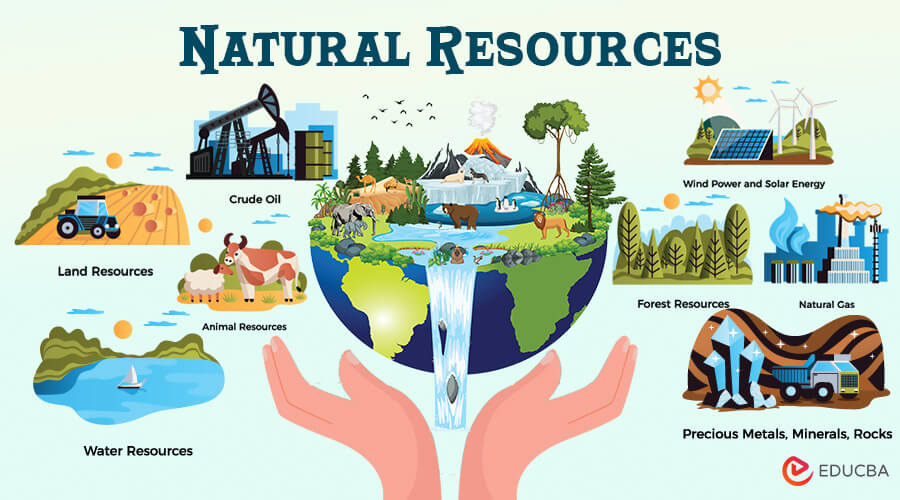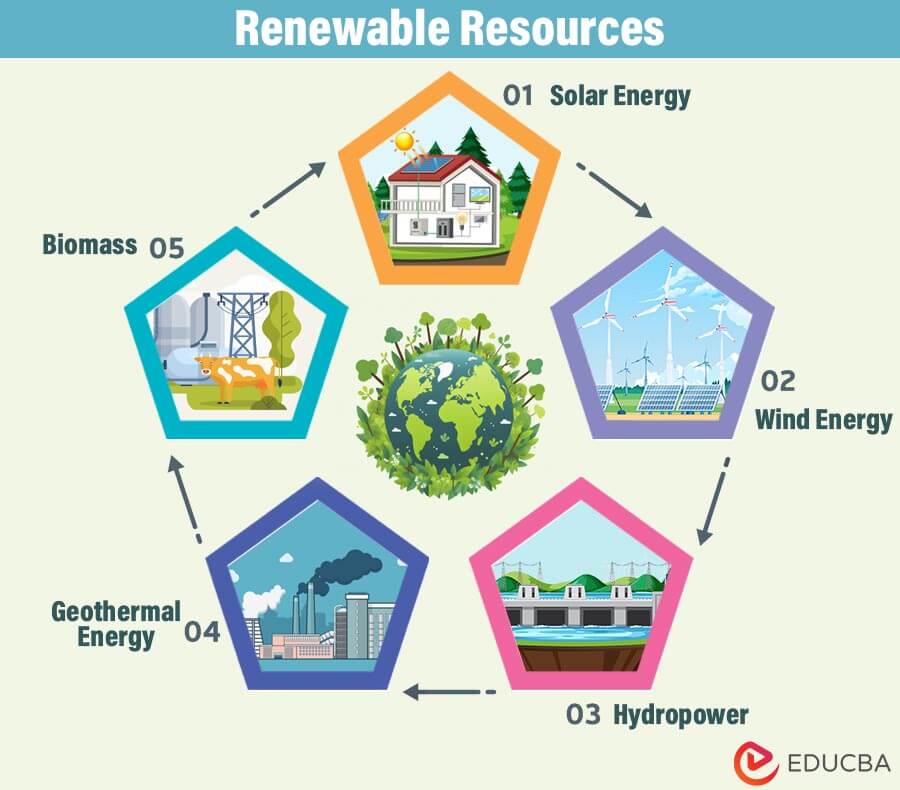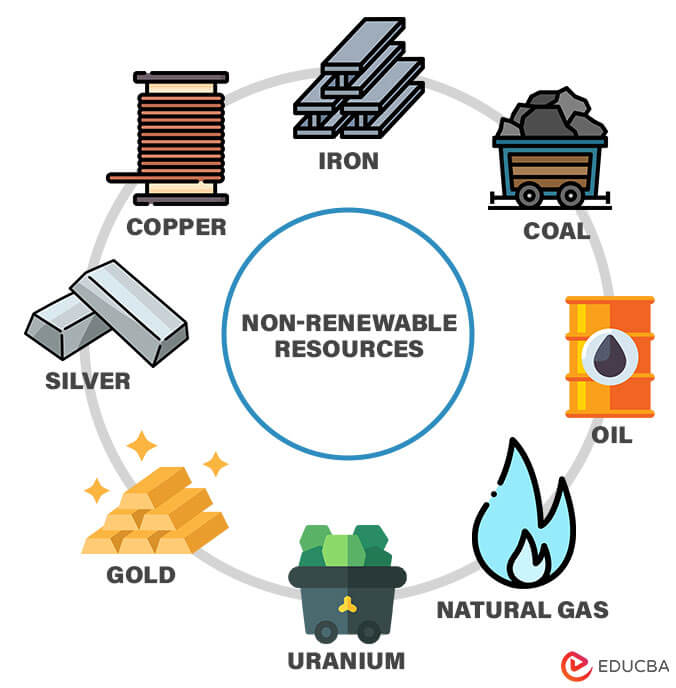Wealth of Nature
Natural resources, the abundant treasures bestowed upon our planet, encompass everything from air and water to minerals and biodiversity. These resources, essential for sustaining life, economic development, and environmental balance, face unprecedented threats. The unrelenting pace of exploitation and the onslaught of pollution have raised alarms about their depletion. Understanding their significance in driving economies, supporting ecosystems, and fostering life, exploring measures to conserve and sustainably manage these invaluable assets is imperative.

Classification of Natural Resources
Natural resources are typically classified into two main categories.
Renewable Resources
Renewable resources, also known as green or sustainable resources, are elements of the Earth that can be naturally replenished over relatively short periods. These resources are pivotal in sustaining life, offering a cleaner and more sustainable alternative to non-renewable resources. Understanding the intricacies of renewable resources is crucial for adopting responsible and eco-friendly practices.
Let’s delve into the details of some key renewable resources:
1. Solar Energy:
- Source: Derived from the sun’s rays that radiate vast amounts of energy.
- Capture Technology: Solar panels, also known as photovoltaic cells, convert sunlight into electricity.
- Applications: Used for residential and commercial power generation, water heating, and space exploration.
- Advantages: Solar energy is abundant, clean, and widely distributed. It has a minimal environmental impact and reduces dependence on fossil fuels.
2. Wind Energy:
- Source: Energy harnessed from the movement of air masses on Earth.
- Capture Technology: Wind turbines convert kinetic energy from the wind into electrical power.
- Applications: Wind farms for electricity generation, both onshore and offshore.
- Advantages: Environmentally friendly, with no direct emissions. Wind energy reduces greenhouse gas emissions and lessens dependence on finite fossil fuels.
3. Hydropower:
- Source: Energy obtained from the gravitational force of flowing water.
- Capture Technology: Dams and turbines convert the kinetic energy of moving water into electricity.
- Applications: Large-scale hydropower plants for electricity generation and smaller-scale projects.
- Advantages: Dependable and Adaptable, offering a steady and regulated energy supply. Another source of sustainable energy is hydropower.
4. Biomass:
- Source: Organic materials such as wood, crop residues, and waste.
- Capture Technology: Biomass is burned or converted into biofuels to produce heat or electricity.
- Applications: Used for heating, cooking, and electricity generation. Biofuels are utilized as an alternative to traditional fossil fuels.
- Advantages: Biomass is carbon-neutral because the carbon dioxide it absorbs during growth balances the carbon dioxide it releases during combustion.
5. Geothermal Energy:
- Source: Heat generated within the Earth’s interior.
- Capture Technology: Geothermal power plants convert heat from the Earth’s interior into electricity.
- Applications: Electricity generation and direct use for heating buildings or spas.
- Advantages: Geothermal energy is reliable and constant, with minimal environmental impact. It provides a continuous and sustainable source of power.
Non-renewable Resources
Non-renewable resources are Earth’s treasures with limited and finite availability, formed over geological timescales. Unlike renewable resources, non-renewable resources are not replenished on human timescales, and their extraction and utilization raise concerns about depletion, environmental impact, and sustainability.
Let’s explore some key non-renewable resources in detail:
1. Fossil Fuels:
- Types: Coal, oil (petroleum), and natural gas.
- Formation: Originated from ancient plant and animal remains buried and exposed to pressure and heat for millions of years.
- Extraction: Extracted through coal mining, oil drilling, and natural gas fracking.
- Applications: Used for electricity generation, transportation, heating, and various industrial processes.
- Challenges: Depletion concerns as extraction rates exceed natural replenishment. Fossil fuel combustion produces greenhouse gasses, which worsen air pollution and contribute to climate change.
2. Minerals and Metals:
- Types: Precious metals (gold, silver), base metals (copper, aluminum), and industrial minerals (iron, limestone).
- Formation: Result of geological processes and often extracted through mining.
- Applications: Used in construction, manufacturing, electronics, and various industries.
- Challenges: Limited availability and environmental impact associated with mining activities, including habitat disruption, soil erosion, and water pollution.
3. Nuclear Fuels:
- Type: Uranium, a radioactive metal.
- Formation: Mined from the Earth’s crust.
- Applications: Primary fuel for nuclear power plants, generating electricity through nuclear fission.
- Challenges: Limited uranium reserves, concerns about nuclear accidents, radioactive waste disposal, and nuclear proliferation.
The Importance of Natural Resources
Understanding the importance of natural resources is vital for promoting sustainable practices and ensuring the well-being of present and future generations.
- GDP Contribution: Natural resources are central to economic development, contributing significantly to nations’ Gross Domestic Product (GDP). Agriculture, forestry, mining, and energy extraction are pivotal for economic growth.
- Employment Opportunities: Many livelihoods are directly linked to natural resource extraction, processing, and utilization. From farmers cultivating crops to workers in mining operations, these resources provide employment opportunities worldwide.
- Energy Production: Important energy sources that power industrial processes, transportation, and electricity production include coal, oil, and natural gas. They have historically powered economic development and technological progress.
- Environmental Balance: Natural habitats and ecosystems are crucial for biodiversity, supporting various plant and animal species. Preserving these environments is essential for maintaining ecological balance and preventing species extinction.
- Agriculture and Food Security: Arable land, freshwater, and fertile soil are fundamental for agriculture. These resources support the cultivation of crops, ensuring food security for the global population.
- Industrial and Technological Advancements: Natural resources serve as raw materials for technological advancements, enabling the creation of new products, medicines, and materials.
Distribution of natural resources around the world
Geological, climatic, and biological variables influence the global distribution of natural resources. Here’s an overview of significant natural resources and their distribution:
Fossil Fuels:
- Oil: Concentrated in regions like the Middle East (Saudi Arabia, Iraq, Iran), Russia, Venezuela, and the United States.
- Natural Gas: Abundant in regions including Russia, the Middle East, the United States, Iran, and Qatar.
- Coal: Widely distributed, with significant reserves in the United States, Russia, China, India, and Australia.
Minerals and Metals:
- Iron Ore: Predominantly found in Australia, Brazil, China, India, and Russia.
- Copper: Major deposits in Chile, Peru, China, the United States, and the Democratic Republic of Congo.
- Gold: Concentrated in countries like China, Russia, Australia, the United States, and Canada.
- Rare Earth Elements: China holds significant reserves, while other deposits exist in countries like Australia, Russia, and the United States.
Agricultural Resources:
- Arable Land: Unevenly distributed, with fertile regions in countries like the United States, India, Brazil, China, and Russia.
- Water Resources: Vary widely, with countries like Brazil, Russia, Canada, Indonesia, and China holding significant freshwater reserves.
- Key Crops: Production hubs vary—corn in the United States, wheat in Russia and the United States, rice in China and India, and soybeans in Brazil and the United States.
Forests and Timber:
- Tropical Forests: Concentrated in regions like the Amazon Basin (Brazil), Congo Basin (Central Africa), and Southeast Asia (Indonesia, Malaysia).
- Temperate Forests: Predominantly found in countries like Russia, Canada, the United States, and Scandinavia.
Renewable Energy Sources:
- Solar and Wind Energy: Available globally but often more viable in regions with abundant sunlight (deserts) or consistent wind patterns (coastal areas or plains).
- Hydropower: Concentrated in countries like China, Brazil, the United States, Canada, and Russia with ample rivers and suitable topography.
Fisheries:
- Marine Resources: Abundant in coastal regions and oceans, with major fishing nations including China, Indonesia, Peru, India, and the United States.
Depletion of Natural Resources
Let’s delve into the ramifications of the depletion of natural resources:
Loss of Biodiversity:
- Habitat Destruction: Many ecosystems are lost due to agriculture, urbanization, and resource extraction from forests, marshes, and other natural habitats. This phenomenon contributes to the extinction of plant and animal species.
- Disruption of Ecological Balance: Depleting one component of an ecosystem can have cascading effects, affecting species that depend on the depleted resource and disrupting the intricate web of interdependencies.
Climate Change:
- Fossil Fuel Depletion: By releasing greenhouse gases into the atmosphere, the exploitation and burning of fossil fuels contribute to climate change. Extreme weather events and the global warming dilemma are made worse by the depletion of these non-renewable resources.
- Deforestation: The depletion of forests reduces their capacity to sequester carbon dioxide, contributing to the greenhouse gas buildup in the atmosphere.
Water Scarcity:
- Over-extraction of Aquifers: Depleting groundwater resources through excessive pumping for agriculture and urban use leads to lowered water tables, increased salinity, and a decline in freshwater availability.
- River Depletion: Rivers can alter their natural flow patterns by dams and diversions for irrigation or hydropower, impacting aquatic ecosystems and communities dependent on these water sources.
Soil Degradation:
- Overfarming and Deforestation: Intensive agricultural practices, deforestation, and improper land management contribute to soil erosion, nutrient depletion, and loss of soil fertility.
- Desertification: Overexploitation of land in arid and semi-arid regions can lead to desertification, rendering once-productive land barren and unsuitable for agriculture.
Resource Conflict:
- Competition for Limited Resources: Depletion of resources, particularly non-renewable ones, can lead to heightened competition and conflicts between nations and communities vying for access to these finite assets.
- Social and Economic Disparities: The unequal distribution of natural resources can exacerbate social and economic disparities, leading to conflicts over resource ownership and access.
Economic Impact:
- Dependency on Non-renewable Resources: Economies heavily reliant on non-renewable resources may encounter difficulties as these resources become scarce, resulting in economic downturns and job losses.
- Disruption of Supply Chains: Depletion of key resources can disrupt global supply chains, affecting industries and markets dependent on these inputs.
Sustainable Practices for Natural Resource Management
Here are several key sustainable practices:
- Conservation and Preservation: Natural resources, including forests, water, soil, and wildlife, must be used and protected responsibly. Preservation seeks to protect ecosystems in their natural state and minimize human interference. Both strategies aim to maintain biodiversity, ecosystem services, and natural habitats.
- Sustainable Agriculture: Implementing agroecology, organic farming, crop rotation, and integrated pest management reduces reliance on harmful chemicals and promotes soil health, biodiversity, and long-term productivity. It also includes practices like precision farming that optimize resource use through data-driven approaches.
- Sustainable Forestry: Adopting sustainable logging practices, such as selective harvesting, reforestation, and reduced-impact logging, ensures the regeneration of forests while preserving biodiversity and ecosystem functions. Forest certification programs, like Forest Stewardship Council (FSC) certification, promote responsible forest management.
- Water Resource Management: Efficient water use through drip irrigation, rainwater harvesting, and water recycling minimizes waste and ensures adequate water supply for agriculture, industry, and communities. Watershed management approaches also protect water sources and maintain water quality.
- Waste Management and Recycling: Implementing waste reduction strategies and recycling programs and promoting the circular economy minimizes resource depletion, decreases pollution, and maximizes the value extracted from materials, reducing the need for virgin resources.
- Ecosystem-Based Approaches: Preserving and rejuvenating ecosystems like wetlands, mangroves, and coral reefs is vital for sustaining natural resources. This practice safeguards habitats, controls water flow, captures carbon, and fosters biodiversity.
Global Trends in Natural Resource Consumption
Global natural resource consumption trends show how people use Earth’s resources worldwide, driven by population growth, technology, and changing consumption. These trends significantly impact the environment, economies, and societies, making it essential to understand them.
- Population Growth: The ever-increasing global population directly influences resource demands. More people translate to higher needs for food, water, energy, shelter, and raw materials. This growth amplifies pressure on resources, particularly in regions experiencing rapid urbanization and industrialization.
- Industrialization and Technology: Advancements in technology and industrial processes have transformed resource extraction, manufacturing, and energy production. Technology enhances efficiency and intensifies resource consumption due to increased manufacturing, energy demands, and complex supply chains.
- Urbanization: The migration of populations from rural areas to cities leads to concentrated resource consumption. Urban areas require massive amounts of resources for infrastructure, housing, transportation, and services, significantly impacting local and global resource demands.
- Changing Consumption Patterns: Evolving lifestyles and consumer behaviors, often influenced by economic growth and cultural shifts, affect resource consumption. Shifts in dietary preferences, increased use of disposable goods, and a culture of rapid obsolescence contribute to resource depletion.
- Resource Intensive Industries: Certain sectors, such as agriculture, mining, and manufacturing, heavily rely on natural resources. Their expansion to meet growing demands exacerbates resource depletion, ecosystem degradation, and pollution.
- Global Trade and Supply Chains: Globalization has led to intricate networks of trade and supply chains, enabling resource sourcing from various regions. This interconnectedness magnifies the environmental footprint of resource extraction and transportation.
Initiatives taken by the government
Governments worldwide undertake various initiatives to address natural resource management and environmental challenges:
- Legislation and Policies: Governments enact laws and policies to regulate resource extraction, land use, pollution control, and conservation efforts. Examples include the Clean Air Act (US), the Water Framework Directive (EU), and the National Green Tribunal (India).
- Protected Areas: Governments establish and manage national parks, marine sanctuaries, and reserves to preserve biodiversity and critical habitats. Notable examples include the Great Barrier Reef Marine Park (Australia), Serengeti National Park (Tanzania), and Yellowstone National Park (US).
- International Agreements: Governments and the Convention on Biological Diversity enter international agreements like the Kyoto Protocol and the Paris Agreement to coordinate actions related to sustainable development, biodiversity conservation, and climate change mitigation.
- Investment in Renewable Energy: To lessen dependency on fossil fuels, governments promote renewable energy sources, including hydroelectric, wind, and solar power, through tax breaks, infrastructure development, and subsidies.
- Environmental Education and Awareness: Governments promote environmental education in schools, public awareness campaigns, and community engagement programs to foster a culture of sustainability and responsible resource management.
- Research and Innovation Funding: Governments allocate funds for research grants, technological innovations, and initiatives to develop sustainable practices, clean technologies, and conservation efforts.
- International Aid and Assistance: Governments provide aid and assistance to developing nations for capacity-building, technology transfer, and sustainable development projects related to natural resource management.
- Regulating Industries: Governments implement regulations and standards for industries regarding waste management, emissions, and sustainable practices to reduce environmental impact.
Case Studies
Here are a few detailed examples:
1. Costa Rica’s Conservation Efforts:
- Background: Agriculture and logging in the 20th century caused extensive deforestation in Costa Rica, posing a threat to its biodiversity and ecosystems.
- Initiatives: The country implemented policies focused on conservation and sustainable practices. It established a national park system, incentivized reforestation through payment for environmental services (PES), and promoted ecotourism.
- Results: The forest cover significantly increased as a result of these activities. By 2020, about 52% of the country’s land area was covered by forests, marking a reversal of deforestation trends. The emphasis on conservation also bolstered the tourism sector, contributing to economic growth.
2. Water Management in Singapore:
- Background: Singapore faced water scarcity due to its limited land area and dependence on neighboring countries for water supply.
- Initiatives: The nation invested in diverse water management strategies. These strategies include NEWater (recycled wastewater for drinking), desalination plants, and the development of reservoirs like Marina Barrage for water catchment.
- Results: Singapore achieved water self-sufficiency, reducing reliance on external sources. The innovative approaches to water management have made the country resilient to droughts and geopolitical uncertainties regarding water access.
3. Sustainable Fisheries in Iceland:
- Background: Overfishing threatened Iceland’s marine ecosystems and fishing industry.
- Initiatives: Iceland implemented a quota-based fisheries management system in the 1980s. It allocated quotas based on scientific assessments of fish stocks, promoted responsible fishing practices, and enforced strict regulations to prevent overfishing.
- Results: The fisheries management system led to the recovery of fish stocks and sustained the fishing industry. Iceland’s approach is lauded globally as a model for sustainable fisheries management.
4. Renewable Energy Transition in Germany:
- Background: Germany aimed to reduce reliance on fossil fuels and nuclear energy, transitioning towards renewable sources.
- Initiatives: The country implemented policies that encouraged the adoption of renewable energy, including the Renewable Energy Sources Act (EEG), feed-in tariffs, and investments in solar, wind, and biomass energy.
- Results: Germany became a global leader in renewable energy production, with renewables contributing significantly to its energy mix. However, challenges related to grid infrastructure, costs, and intermittency persist.
5. Community-Based Conservation in Namibia:
- Background: Namibia faced threats to wildlife due to poaching and conflicts between communities and wildlife.
- Initiatives: Local communities were given the opportunity to manage wildlife and benefit from conservation-related activities, like ecotourism and sustainable hunting, through the establishment of community conservancies.
- Results: Community involvement reduced poaching, habitat preservation, and economic benefits for local populations. This approach empowered communities to become stewards of their natural resources.
Conclusion
The intricate tapestry of natural resources weaves the fabric of our existence. Urgent action is imperative to balance our insatiable demands with sustainable practices, ensuring a legacy of abundance for future generations. We can safeguard the Earth’s vitality by embracing conservation, sustainable technologies, and global cooperation. Our collective responsibility is to nurture and protect these invaluable resources, fostering a harmonious coexistence between humanity and the planet that sustains us.


